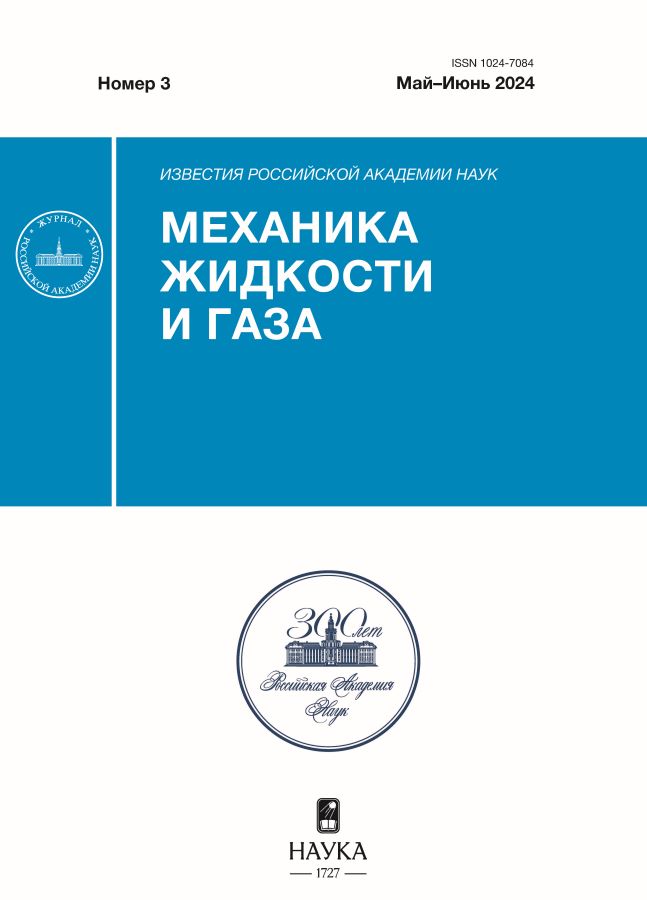Numerical Simulation of Tollmien-Schlichting Wave Generation by Flow Turbulence
- 作者: Ustinov M.V.1,2
-
隶属关系:
- Zhukovski Central Aerohydrodynamic Institute (TsAGI)
- Moscow Institute of Physics and Technology (MPhTI)
- 期: 编号 3 (2024)
- 页面: 122-136
- 栏目: Articles
- URL: https://rjonco.com/1024-7084/article/view/682517
- DOI: https://doi.org/10.31857/S1024708424030094
- EDN: https://elibrary.ru/PFHBHN
- ID: 682517
如何引用文章
详细
The disturbances generated by external turbulence in the shear layer on a flat plate suddenly set in motion are found. As the initial conditions, turbulent flow found using direct numerical simulation of the development of isotropic homogeneous turbulence is used. The solution obtained models laminar-turbulent transition in the boundary layer on a flat plate under relatively low free-stream turbulence when the transition is caused by Tollmien-Schlichting waves. The solution makes it possible to describe the process of generating various disturbances, namely, low-frequency streaky structures and instability waves and also their development in the initial stage of laminar-turbulent transition. Based on the processing of the obtained results, a simple model is proposed that relates the spectra of instability waves in the boundary layer and turbulent pulsations in free-stream flow. The dependences of the initial amplitude of instability waves and their critical amplification factors (N-factors) on the degree of flow turbulence are also obtained.
全文:
作者简介
M. Ustinov
Zhukovski Central Aerohydrodynamic Institute (TsAGI); Moscow Institute of Physics and Technology (MPhTI)
编辑信件的主要联系方式.
Email: umax1961@gmail.com
俄罗斯联邦, Zhukovsky, Moscow oblast; Dolgoprudny, Moscow oblast
参考
- Ustinov M.V., Kachanov Y.S Comparison of amplitude method of roughness-induced swept-wing transition prediction with experiment // Physics of Fluids. 2021. V. 33 (9). 094105.
- Чувахов П.В., Федоров А.В. Статистическая модель начальной стадии ламинарно-турбулентного перехода, вызванного атмосферными микрочастицами// Тез.докл. 13 Всероссийский съезд по проблемам теоретической и прикладной механики, Санкт-Петербург, 21–25 августа 2023 г.
- Goldstein M.E. The evolution of Tollmien–Schlichting waves near the leading edge//J. Fluid Mech. 1983. V.127. P. 59–81.
- Качанов Ю.С., Козлов В.В., Левченко В.Я. Возникновение волны Толлмина–Шлихтинга в пограничном слое при воздействии внешних возмущений//Изв. АН СССР. МЖГ. 1978. С. 85–94.
- Жигулев В.Н, Федоров А.В. Исследованиевозбуждения волн Толлмина–Шлихтинга. Препринт СО АН СССР, 1982. С 27–33.
- Жигулев В.Н., Тумин А.М. Возникновение турбулентности. Динамическая теория возбуждения и развития неустойчивостей в пограничных слоях. Новосибирск: Наука, 1987. 280 с.
- Устинов М.В. Генерация волн Толлмина–Шлихтинга турбулентностью потока// Изв. РАН. МЖГ. 2014. № 4. С. 58–72
- Mack L.M. Transition prediction and linear stability theory // AGARD Conf. proc. CP-224. 1977. P. 1/1–22.
- Parekh D.E., Pulin P., Wlezin R.W. Boundary layer receptivity to convected gusts and sound //Boundary Layer Stability and Transition to Turbulence FED-114/ Ed. C.L. Reda et al. N.Y.: ASME, 1991. P. 69–76.
- Buter T.A., Reed H.L. Numerical investigations of receptivity to freestream vorticity // AIAA Paper.1993. № 93–0073.
- Leib S.J., Wundrow D.W., Goldstein M.E. Effects of free-stream turbulence and other vortical disturbances on a laminar boundary layer // J. Fluid Mech. 1999. V. 380. P. 169–203.
- Устинов М.В. Восприимчивость пограничного слоя на плоской пластине к турбулентности набегающего потока//Изв. РАН МЖГ. 2003. № 3. С. 56–68
- Устинов М.В. Численное моделирование развития полосчатой структуры в пограничном слое при повышенной степени турбулентности потока//Изв. РАН МЖГ. 2004. № 2. С. 103–119
- Rozhdestvensky B.L., Simakin I.N. Secondary flows in a plane channel: their relationship and comparison with turbulent flows// J. Fluid Mech.1987. P. 261–289.
- Гуляев А.Н., Козлов В.Е., Кузнецов В.Р. Проникновение трехмерных низкочастотных пульсаций скорости внешнего потока в ламинарный пограничный слой на плоской пластине// Труды ЦИАМ.1991. № 1287.С. 197–236.
- Устинов М.В. Численное моделирование ламинарно-турбулентного перехода в пограничном слое при повышенной степени турбулентности потока//Изв. РАН МЖГ. 2006. № 6. С. 77–93
- Рождественский Б.Л., Стойнов М.И. Алгоритмы интегрирования уравнений Навье–Стокса, имеющие аналоги законам сохранения массы, импульса и энергии. Препринт № 119 ИПМ им. М.В. Келдыша. 1987. 28 с.
- Устинов М.В. Исследование субгармонического перехода в плоском канале методом прямого численного моделирования// Изв. АНСССРМЖГ. 1993. № 3. C. 46–53
- Westin K.J.A., Boiko A.V., Klingmann B.G., Kozlov V.V., Alfredsson P.H. Experiments in a boundary layer subjected to freestream turbulence. Pt I: Boundary layer structure and receptivity// J. Fluid Mech. 1994. V. 281. P. 193–218.
- Matsubara M., Alfredsson P.H. Disturbance growth in boundary layers subjected to free-stream turbulence// J. Fluid Mech. 2001. V. 430. P. 149–168.
- Филиппов В.М. Экспериментальное исследование влияния градиента давления на переход ламинарного пограничного слоя в турбулентный// Уч. зап. ЦАГИ. 1975.Т. 6. № 6. С. 114–118.
补充文件


















